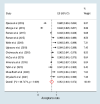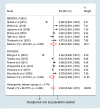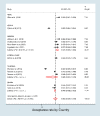A systematic review and meta-analysis of the prevalence of caregiver acceptance of malaria vaccine for under-five children in low-income and middle-income countries (LMICs)
- PMID: 36455209
- PMCID: PMC9715017
- DOI: 10.1371/journal.pone.0278224
A systematic review and meta-analysis of the prevalence of caregiver acceptance of malaria vaccine for under-five children in low-income and middle-income countries (LMICs)
Abstract
Introduction: Malaria is the second leading cause of death in children after diarrheal disease, with low- and middle-income countries (LMICs) accounting for over 9 in 10 incidence and deaths. Widespread acceptance and uptake of the RTS,S vaccine, recently approved by the world health organization (WHO), is projected to significantly reduce malaria incidence and deaths. Therefore, we conducted this systematic review and meta-analysis with the aim to determine the malaria vaccine acceptance rate and the factors associated with acceptance.
Methods: We searched six databases including Google Scholar, PubMed, Cochrane, African Index Medicus, The Regional Office for Africa Library, and WHO Institutional Repository for Information Sharing (IRIS) to identify studies evaluating the malaria vaccine acceptance rate. This systematic review and meta-analysis followed the Preferred Reporting Items for Systematic Review and Meta-analysis (PRISMA) guidelines. Studies were included if they were original articles published in the English language in peer-reviewed journals and assessed the prevalence of willingness to accept a free malaria vaccine, and not qualitative. The risk of publication bias was checked using both Beggar's funnel plot and Egger's test, while the I2 statistic was used to assess the heterogeneity of the included studies. Study quality was determined using the Newcastle-Ottawa scale. A meta-analysis was performed using a random effects model to evaluate the pooled prevalence of malaria vaccine acceptance. The protocol for this article was registered prospectively on the International Prospective Register for Systematic Reviews (PROSPERO), with ID number CRD42022334282).
Results: Our analysis included 11 studies with a total sample size of 14, 666 participants. The aggregate malaria vaccine acceptance rate was 95.3% (95% CI:93.0%-97.2%). Among the general population, the acceptance rate was 96.3% (95% CI:92.0%-99.0%) and among mothers, it was 94.4% (95% CI:90.8%-97.2%). By country, Nigeria had the highest acceptance rate (97.6%, 95% CI:96.0%-98.8%), followed by Ghana (94.6%, 95% CI:93.8%-95.3%) and Tanzania (92.5%, 95% CI:84.4%-97.8%). Sociodemographic determinants of vaccine acceptance included place of residence, tribe, age, sex, occupation, and religion. Reasons for low acceptance included safety concerns, efficacy profile, vaccine's requirement for multiple injections, and poor level of awareness.
Conclusion: Future efforts should be focused on identifying factors that may improve the actual uptake of the RTS,S vaccine in malaria-endemic communities.
Copyright: © 2022 Sulaiman et al. This is an open access article distributed under the terms of the Creative Commons Attribution License, which permits unrestricted use, distribution, and reproduction in any medium, provided the original author and source are credited.
Conflict of interest statement
The authors have declared that no competing interests exist.
Figures
Similar articles
-
Community readiness and acceptance for the implementation of a novel malaria vaccine among at-risk children in sub-saharan Africa: a systematic review protocol.Malar J. 2024 Jun 10;23(1):182. doi: 10.1186/s12936-024-04995-y. Malar J. 2024. PMID: 38858779 Free PMC article.
-
COVID-19 vaccine acceptance and its associated factors in Ethiopia: A systematic review and meta-analysis.Clin Epidemiol Glob Health. 2022 Mar-Apr;14:101001. doi: 10.1016/j.cegh.2022.101001. Epub 2022 Mar 7. Clin Epidemiol Glob Health. 2022. PMID: 35284688 Free PMC article. Review.
-
Malaria vaccine-related adverse events among children under 5 in sub-Saharan Africa: systematic review and meta-analysis protocol.BMJ Open. 2023 Oct 4;13(10):e076985. doi: 10.1136/bmjopen-2023-076985. BMJ Open. 2023. PMID: 37793915 Free PMC article.
-
Burden and determinants of scabies in Ethiopian school age children: A systematic review and meta-analysis with public health implications.PLoS One. 2024 Dec 19;19(12):e0314882. doi: 10.1371/journal.pone.0314882. eCollection 2024. PLoS One. 2024. PMID: 39700220 Free PMC article.
-
Prevalence, determinants, and reasons for malaria vaccine hesitancy among caregivers of under-five children in Nigeria: Results from a nationwide cross-sectional survey.Vaccine. 2023 Feb 17;41(8):1503-1512. doi: 10.1016/j.vaccine.2023.01.060. Epub 2023 Jan 31. Vaccine. 2023. PMID: 36725434
Cited by
-
Willingness to accept malaria vaccines amongst women presenting at outpatient and immunization clinics in Enugu state, Southeast Nigeria.Malar J. 2024 Apr 25;23(1):117. doi: 10.1186/s12936-024-04914-1. Malar J. 2024. PMID: 38664783 Free PMC article.
-
Community readiness and acceptance for the implementation of a novel malaria vaccine among at-risk children in sub-saharan Africa: a systematic review protocol.Malar J. 2024 Jun 10;23(1):182. doi: 10.1186/s12936-024-04995-y. Malar J. 2024. PMID: 38858779 Free PMC article.
-
Malaria vaccination in Africa: A mini-review of challenges and opportunities.Medicine (Baltimore). 2024 Jun 14;103(24):e38565. doi: 10.1097/MD.0000000000038565. Medicine (Baltimore). 2024. PMID: 38875411 Free PMC article. Review.
-
Global partnerships in combating tropical diseases: assessing the impact of a U.S. withdrawal from the WHO.Trop Med Health. 2025 Mar 10;53(1):36. doi: 10.1186/s41182-025-00722-8. Trop Med Health. 2025. PMID: 40065473 Free PMC article. Review.
-
Community readiness and acceptance for the implementation of the malaria vaccine among caretakers of at-risk children in sub-Saharan Africa: a systematic review and meta-analysis.Malar J. 2025 Aug 12;24(1):259. doi: 10.1186/s12936-025-05384-9. Malar J. 2025. PMID: 40797258 Free PMC article.
References
-
- Prevention CC for DC and. CDC—Malaria—Malaria Worldwide—Impact of Malaria. Published December 16, 2021. Accessed May 15, 2022. https://www.cdc.gov/malaria/malaria_worldwide/impact.html.
-
- World malaria report 2021. Accessed April 27, 2022. https://www.who.int/publications-detail-redirect/9789240040496.
-
- WHO recommends groundbreaking malaria vaccine for children at risk. Accessed April 26, 2022. https://www.who.int/news/item/06-10-2021-who-recommends-groundbreaking-m....
Publication types
MeSH terms
Substances
LinkOut - more resources
Full Text Sources






